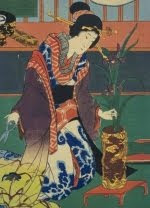Passion, longing and despair are central motives in the art of Edvard Munch. The painting "The Dance of Life" (1899) pictures a midsommer night with dancing couples in the sunlit night.

This painting has been interpreted as a reflection of his own turbulent relationship with love. Munch himself is dancing with a woman in red, the passion of his life who betrayed him. When he again is struck by love Munch is not able to respond and he becomes the one who betrays, leaving the lover in grief.
"I am dancing with my true love - a memory of her.
A smiling, blond-haired woman enters
who wishes to take the flower of love
- but it won't allow itself to be taken.
And on the other side one can see her
dressed in black troubled by the couple dancing
- rejected - as I was rejected from her"
(from Munch's diary)
"The Dance of Life".
Wild rose, white and red bush roses,
Monkshood.
I'm using three vases by a friend of mine, and winding or dancing branches of wild roses to capture the energy between the three main characters in the painting. White and red bush roses and dark purple black Monkshood are used to reflect the different roles in the dance of life. White being the colour of expectation and hope, red the colour of passion and life, and black beeing the colour of greif and death.












2 comments:
beautiful work
Thanks Malu. I'm glad you like it. The vases are porcelain and faience.
Post a Comment